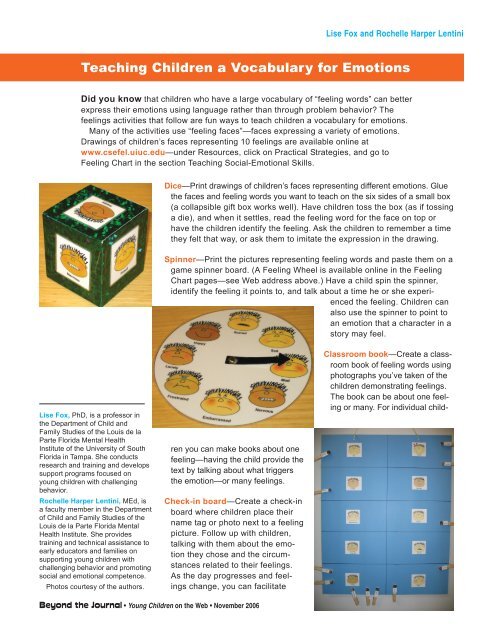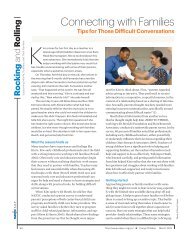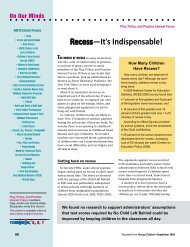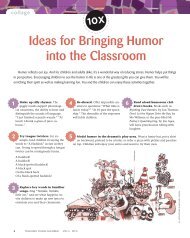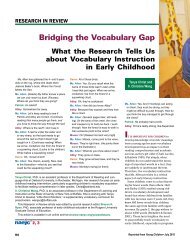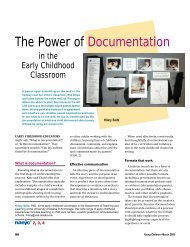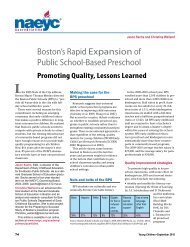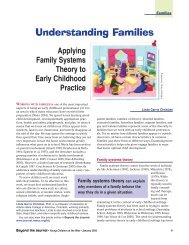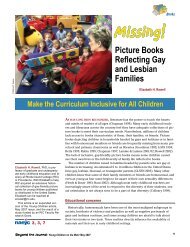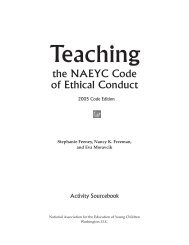Teaching Children a Vocabulary for Emotions - National Association ...
Teaching Children a Vocabulary for Emotions - National Association ...
Teaching Children a Vocabulary for Emotions - National Association ...
Create successful ePaper yourself
Turn your PDF publications into a flip-book with our unique Google optimized e-Paper software.
<strong>Teaching</strong> <strong>Children</strong> a <strong>Vocabulary</strong> <strong>for</strong> <strong>Emotions</strong><br />
Did you know that children who have a large vocabulary of “feeling words” can better<br />
express their emotions using language rather than through problem behavior? The<br />
feelings activities that follow are fun ways to teach children a vocabulary <strong>for</strong> emotions.<br />
Many of the activities use “feeling faces”—faces expressing a variety of emotions.<br />
Drawings of children’s faces representing 10 feelings are available online at<br />
www.csefel.uiuc.edu—under Resources, click on Practical Strategies, and go to<br />
Feeling Chart in the section <strong>Teaching</strong> Social-Emotional Skills.<br />
Lise Fox, PhD, is a professor in<br />
the Department of Child and<br />
Family Studies of the Louis de la<br />
Parte Florida Mental Health<br />
Institute of the University of South<br />
Florida in Tampa. She conducts<br />
research and training and develops<br />
support programs focused on<br />
young children with challenging<br />
behavior.<br />
Rochelle Harper Lentini, MEd, is<br />
a faculty member in the Department<br />
of Child and Family Studies of the<br />
Louis de la Parte Florida Mental<br />
Health Institute. She provides<br />
training and technical assistance to<br />
early educators and families on<br />
supporting young children with<br />
challenging behavior and promoting<br />
social and emotional competence.<br />
Photos courtesy of the authors.<br />
Dice—Print drawings of children’s faces representing different emotions. Glue<br />
the faces and feeling words you want to teach on the six sides of a small box<br />
(a collapsible gift box works well). Have children toss the box (as if tossing<br />
a die), and when it settles, read the feeling word <strong>for</strong> the face on top or<br />
have the children identify the feeling. Ask the children to remember a time<br />
they felt that way, or ask them to imitate the expression in the drawing.<br />
Spinner—Print the pictures representing feeling words and paste them on a<br />
game spinner board. (A Feeling Wheel is available online in the Feeling<br />
Chart pages—see Web address above.) Have a child spin the spinner,<br />
identify the feeling it points to, and talk about a time he or she experienced<br />
the feeling. <strong>Children</strong> can<br />
also use the spinner to point to<br />
an emotion that a character in a<br />
story may feel.<br />
ren you can make books about one<br />
feeling—having the child provide the<br />
text by talking about what triggers<br />
the emotion—or many feelings.<br />
Check-in board—Create a check-in<br />
board where children place their<br />
name tag or photo next to a feeling<br />
picture. Follow up with children,<br />
talking with them about the emotion<br />
they chose and the circumstances<br />
related to their feelings.<br />
As the day progresses and feelings<br />
change, you can facilitate<br />
Lise Fox and Rochelle Harper Lentini<br />
Classroom book—Create a classroom<br />
book of feeling words using<br />
photographs you’ve taken of the<br />
children demonstrating feelings.<br />
The book can be about one feeling<br />
or many. For individual child-<br />
Beyond the Journal • Young <strong>Children</strong> on the Web November 2006 1
children’s changing<br />
the placement<br />
of their name tag<br />
to indicate their<br />
new feelings.<br />
Puppets—<strong>Children</strong><br />
can create puppets<br />
that discuss<br />
feelings and roleplay<br />
classroom<br />
situations. Print<br />
pictures of a<br />
Thinking about<br />
emotions during<br />
story time—While<br />
reading children’s<br />
books, stop<br />
periodically and<br />
ask the children<br />
what a character<br />
is feeling. You may<br />
wish to have a<br />
chart of feeling<br />
pictures <strong>for</strong> the<br />
children to scan or<br />
point to when<br />
responding.<br />
variety of feeling faces and give children each a<br />
set of faces with Velcro tabs to attach interchangeably<br />
on their puppet’s face. <strong>Children</strong> can<br />
complete the puppet by adding hair and clothing.<br />
Bingo—<strong>Children</strong> can play bingo using feeling pictures<br />
in place of the traditional numbers. When<br />
you pull a card with a feeling picture out of a bag,<br />
ask the children to identify the feeling, make the<br />
expression on their faces, and then place a marker<br />
on the appropriate face on their bingo card.<br />
Beyond the Journal Young <strong>Children</strong> on the Web November 2006 2
Child-Friendly Ideas <strong>for</strong> <strong>Teaching</strong> Problem Solving<br />
Problem solving is a complex skill <strong>for</strong> young children to master. Yet, children’s<br />
inability to problem solve can often lead to challenging behavior. Here are some childfriendly<br />
ideas <strong>for</strong> teaching problem solving.<br />
Find graphics <strong>for</strong> the four Problem-Solving Steps (in the puppet activity) and <strong>for</strong> the<br />
Solution Kit activity online at www.csefel.uiuc.edu—under Resources, click on Practical<br />
Strategies, and go to the section <strong>Teaching</strong> Social-Emotional Skills.<br />
Copyright © 2006 by the <strong>National</strong> <strong>Association</strong> <strong>for</strong> the<br />
Education of Young <strong>Children</strong>. See Permissions and<br />
Reprints online at<br />
www.journal.naeyc.org/about/permissions.asp.<br />
teach, cue, and<br />
assist with<br />
problem solving<br />
during classroom<br />
situations.<br />
Problem-solver puppet—Have a class puppet<br />
help you teach children how to problem solve.<br />
The puppet can show the children picture cards<br />
to teach them the steps to problem solving. The<br />
puppet can also provide feedback and encouragement<br />
to children when they use their problemsolving<br />
skills and review at the end of the day<br />
who was a problem solver and why.<br />
Solution Kit—The Solution Kit can be used to<br />
teach children possible solutions to a variety of<br />
problems (the kit is available at http://csefel.<br />
uiuc.edu/modules-archive/module2/handouts/<br />
9.pdf). You can use the pictures from the kit to<br />
Role play—You<br />
can use roleplaying<br />
to show<br />
children examples<br />
of both<br />
effective and<br />
inappropriate<br />
ways to problem<br />
solve. You can<br />
share situations with the children to act out or read scenarios from a<br />
storybook.<br />
Beyond the Journal Young <strong>Children</strong> on the Web November 2006 3


